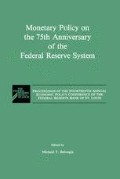Abstract
Among the many excellent ideas contained in Rotemberg’s comments is a proposed new monetary aggregate, which Rotemberg calls the CE (currency equivalent) index. My reply consists primarily of the proof of a theorem regarding that index. The theorem supports Rotemberg’s index by providing a derivation of his index directly from economic theory, when the index is treated as a measure of the economic stock of money under stationary expectations.
Access this chapter
Tax calculation will be finalised at checkout
Purchases are for personal use only
Preview
Unable to display preview. Download preview PDF.
References
Barnett, William A. 1978.“The User Cost of Money.” Economics Letters 1:145–149.
Barnett, William A. 1980.“Economic Monetary Aggregates: An Application of Index Number and Aggregation Theory.” Journal of Econometrics 14:11–48.
Barnett, William A. 1981. Consumer Demand and Labor Supply.Goods, Monetary Assets, and Time. Amsterdam: North-Holland.
Barnett, William A. 1982.“The Optimal Level of Monetary Aggregation.” Journal of Money, Credit, and Banking 14:687–710.
Barnett, William A. 1987.“The Microeconomic Theory of Monetary Aggregation.” In William A. Barnett and Kenneth J. Singleton (Eds.), New Approaches to Monetary Economics. Proceedings of the Second International Symposium in Economic Theory and Econometrics. Cambridge: Cambridge University Press.
Barnett, William A. 1990.“Developments in Monetary Aggregation Theory.” Journal of Policy Modeling 12 No. 2 (September):205–257.
Barnett, William A., and Choi, Seungmook S. 1989.“A Monte Carlo Study of Tests of Blockwise Weak Separability.” Journal of Business and Economic Statistics 7 (July):363–377.
Barnett, William A., Fisher, Douglas, and Serletis, Apostolos. 1989.“Consumer Theory and the Demand for and Measurement of Money.” University of Texas at Austin, North Carolina State University, and University of Calgary.
Barnett, William A., Hinich, Melvin, and Yue, Piyu. 1989.“Monetary Policy with the Exact Theoretical Rational Expectations Monetary Aggregates.” University of Texas at Austin.
Barnett, William A., Hinich, Melvin, and Yue, Piyu. 1990.“Monitoring Monetary Aggregates under Risk Aversion.” Michael T. Belongia (Ed.). Monetary Policy on the 75th Anniversary of the Federal Reserve System. Boston: Kluwer Academic Publishers, pp. 189–223.
Belongia, Michael, and Chalfant, James. 1989.“The Changing Empirical Definition of Money: Some Estimates from a Model of the Demand for Money Substitutes.” Journal of Political Economy 97 (April):387–398.
Diewert, W. Erwin. 1976.“Exact and Superlative Index Numbers.” Journal of Econometrics 4:115–145.
Merton, Robert C. 1989.“Capital Market Theory and the Pricing of Financial Securities.” Working Paper #90–024, Harvard Business School, September.
Pesek, B. P., and Saving, T. R. 1967. Money, Wealth, Economic Theory. New York: Macmillan.
Poterba, James M., and Rotemberg, Julio J. 1987.“Money in the Utility Function: An Empirical Implementation.” In William Barnett and Kenneth Singleton (Eds.), New Approaches to Monetary Economics, Proceedings of the Second International Symposium in Economic Theory and Econometrics. Cambridge: Cambridge University Press, pp. 219–240.
Rotemberg, Julio J. 1990.“Monetary Aggregates and their Uses.” Michael T. Belongia (Ed.). Monetary Policy on the 75th Anniversary of the Federal Reserve System. Boston: Kluwer Academic Publishers, pp. 224–232.
Editor information
Editors and Affiliations
Rights and permissions
Copyright information
© 1991 Springer Science+Business Media New York
About this chapter
Cite this chapter
Barnett, W.A. (1991). A Reply to Julio J. Rotemberg. In: Belongia, M.T. (eds) Monetary Policy on the 75th Anniversary of the Federal Reserve System. Springer, Dordrecht. https://doi.org/10.1007/978-94-011-3888-8_12
Download citation
DOI: https://doi.org/10.1007/978-94-011-3888-8_12
Publisher Name: Springer, Dordrecht
Print ISBN: 978-94-010-5731-8
Online ISBN: 978-94-011-3888-8
eBook Packages: Springer Book Archive

